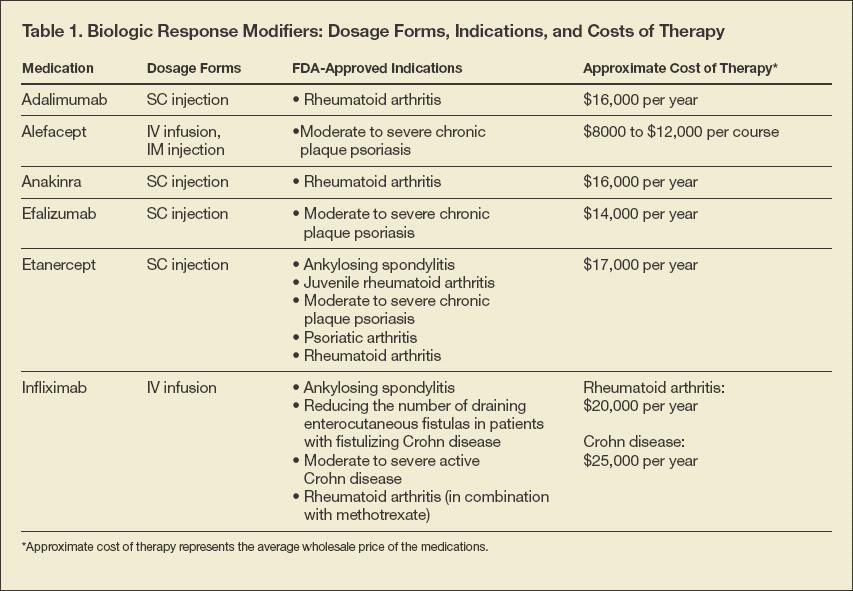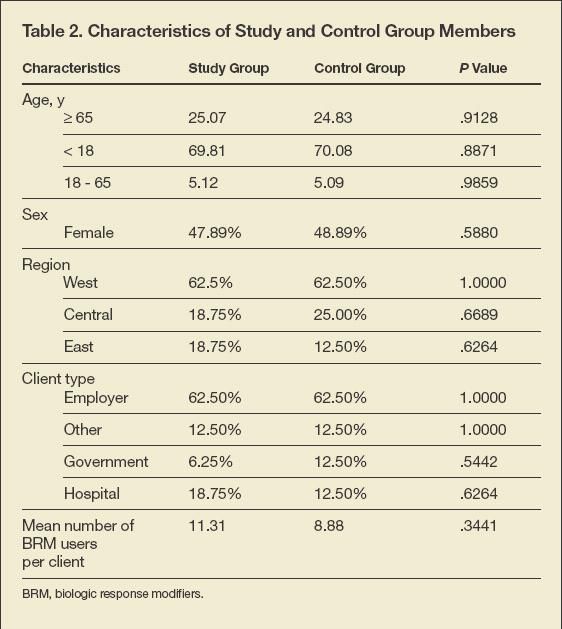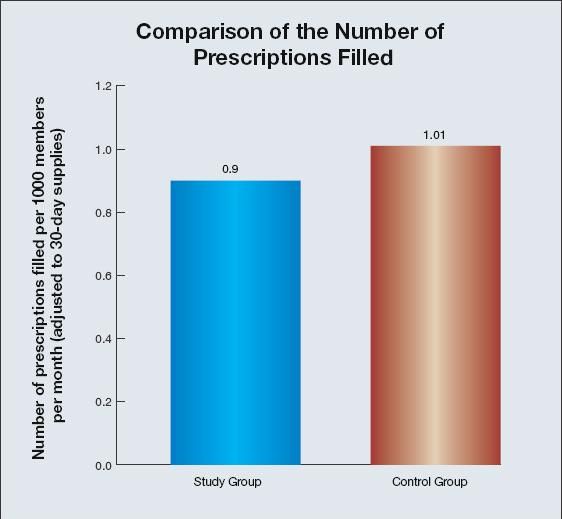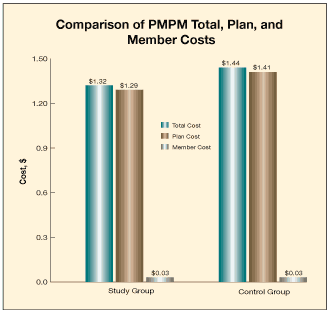
- Clinical Technology
- Adult Immunization
- Hepatology
- Pediatric Immunization
- Screening
- Psychiatry
- Allergy
- Women's Health
- Cardiology
- Pediatrics
- Dermatology
- Endocrinology
- Pain Management
- Gastroenterology
- Infectious Disease
- Obesity Medicine
- Rheumatology
- Nephrology
- Neurology
- Pulmonology
Economic Evaluation of a Prior Authorization Program for Biologic Response Modifiers
Specialty medications constitute the fastest-growing segment of drug spending under the pharmacy benefit. This study evaluated the impact of a specialty pharmacy prior authorization (PA) program on prescription drug costs for biologic response modifiers (BRMs) used in the treatment of persons with rheumatoid arthritis, juvenile rheumatoid arthritis, Crohn disease, ankylosing spondylitis, psoriatic arthritis, psoriasis, and other spondyloarthropathies. A retrospective, case-control, one-to-one matching approach based on patient age, sex, and client characteristics was used. Case clients were enrolled in the specialty pharmacy PA program from January 1 through December 31, 2005. The control group consisted of clients who were not enrolled in the program during this time. The average costs per eligible member per month (PMPM), for the total, plan, and member were $1.32, $1.29, and $0.03, respectively, in the case group, and $1.44, $1.41, and $0.03, respectively, in the control group. Clients who implemented the specialty pharmacy PA program for BRMs saved an estimated total cost of $0.12 PMPM. Implementing a specialty pharmacy PA program reduced BRM costs. (Drug Benefit Trends. 2008;20:26-31)
Specialty medications constitute the fastest-growing segment of drug spending under the pharmacy benefit. This study evaluated the impact of a specialty pharmacy prior authorization (PA) program on prescription drug costs for biologic response modifiers (BRMs) used in the treatment of persons with rheumatoid arthritis, juvenile rheumatoid arthritis, Crohn disease, ankylosing spondylitis, psoriatic arthritis, psoriasis, and other spondyloarthropathies. A retrospective, case-control, one-to-one matching approach based on patient age, sex, and client characteristics was used. Case clients were enrolled in the specialty pharmacy PA program from January 1 through December 31, 2005. The control group consisted of clients who were not enrolled in the program during this time. The average costs per eligible member per month (PMPM), for the total, plan, and member were $1.32, $1.29, and $0.03, respectively, in the case group, and $1.44, $1.41, and $0.03, respectively, in the control group. Clients who implemented the specialty pharmacy PA program for BRMs saved an estimated total cost of $0.12 PMPM. Implementing a specialty pharmacy PA program reduced BRM costs. (Drug Benefit Trends. 2008;20:26-31)
Specialty pharmaceuticals are costly and are typically administered by either injection or infusion to manage complex conditions, including multiple sclerosis (MS), rheumatoid arthritis (RA), hepatitis C, hemophilia, and some forms of cancer.1
Specialty medications constitute the fastest-growing segment of drug spending under the pharmacy benefit. They represent a relatively new area of prescription medications with generally smaller patient populations. 2 Although the percentage of persons taking specialty medications is less than 3%, these patients account for 25% to 30% of total medical costs for private health care payers.3
According to the Pharmaceutical Research and Manufacturers of America, the annual cost of specialty medications is "growing 2 times faster than traditional ambulatory drug products."4 Annual spending on these medications has exploded from $22 billion in 2001 to an estimated $40 billion in 2005 and is expected to reach as high as $1.7 trillion by 2030.5 With the introduction of more costly treatments, it is becoming increasingly important to manage these treatments effectively, especially in the ambulatory care setting. Payers are becoming alarmed by the expanding uses of specialty medications, which are increasingly being prescribed to manage more common conditions, such as RA, psoriasis, and even asthma, with prevalence estimates of 1%, 2.2%, and 6.7%, respectively.6-9
As more specialty medications become available and costs increase, plans and PBMs are implementing a variety of strategies to manage the use of specialty medications and control costs, including use of tiered formularies, step therapy, and prior authorization (PA). The high cost of specialty medications also puts patients at risk for increased cost-sharing and higher out-of-pocket payments. Ensuring appropriateness of therapy and access to medications is a challenge.10
Biologic response modifiers (BRMs) are among the most commonly used specialty medications. They are used mostly for the treatment of persons with RA.11 RA, a chronic autoimmune inflammatory disease associated with significant pain, joint destruction, and loss of mobility, typically follows a variable course characterized by exacerbations, remissions, and variable outcomes. Most patients require medical treatment to control disease flare-ups.
According to the Arthritis Foundation, RA affects more than 2 million US persons. The incidence of RA increases with age. This disease has significant economic consequences for patients and plans, with direct health care costs averaging 2 to 3 times more than costs for persons without RA.12,13 More than 9 million doctor visits and 250,000 hospitalizations per year are attributed to RA.14 The economic costs associated with RA are high, approximating those of coronary heart disease.15,16 The direct and indirect medical costs for RA in the United States were estimated at $26 billion to $32 billion per year (in 1998 dollars).17
BRMs have the potential to reduce inflammation and structural damage to joints by blocking the action of cytokines, proteins that trigger inflammation during a normal immune response.14,18 Generally, BRMs are recommended for use in patients with moderate to severe active RA who have failed to respond to an adequate trial of an oral disease-modifying antirheumatic drug (DMARD). BRMs, such as anakinra (Kineret) and adalimumab (Humira), can be added to DMARD regimens.14,18
Some BRMs are also FDA-approved for the treatment of persons with ankylosing spondylitis (AS), Crohn disease, and psoriasis.11 AS is a chronic inflammatory rheumatic disease of the axial skeleton with variable involvement of peripheral joints and nonarticular structures. It is estimated to afflict 300,000 to 1 million Americans, making it more common than MS, cystic fibrosis, and amyotrophic lateral sclerosis combined. Crohn disease is characterized by inflammation of the GI tract with or without systemic and extraintestinal involvement. Therapy is needed to maintain symptom control, improve quality of life, and minimize complications. Psoriasis is an inflammatory condition in which a thick, rough, dry buildup of skin (plaques) is formed. About 4.5 million US persons are affected by the condition, which has a strong genetic component, with 1.5 million cases classified as moderate to severe.
The annual cost of therapy with BRMs ranges from $16,000 to $20,000 compared with $400 to $3600 with first-line therapies, including NSAIDs and DMARDs. In part, because of concerns regarding long-term safety, BRMs are more likely to be used as second-line therapy.
A national PBM developed a BRM PA program using evidence-based medicine and clinical guidelines to help ensure that first-line therapies are used before initiation of BRMs and that BRMs are used appropriately.14,18
Use of PA requires that physicians obtain approval from the health plan or PBM before prescribing the drug to receive reimbursement. The PA program was instituted to ensure appropriate use of the high-cost BRMs.18,19 The first step was to confirm the patient's diagnosis. Next, severity of the disease was assessed. If patients showed moderate to severe symptoms, then contraindications and hypersensitivity to the specific BRM were evaluated.
Additional steps were included in the protocol to ensure that other, less costly treatments had been considered. Patients' clinical characteristics, such as the presence of an infection or hematological abnormalities or whether the patient was pregnant, were taken into account. If the patient had a serious infection, was recovering from an infection, had a hematological abnormality, or was pregnant, the request to prescribe a BRM was denied. Approval or denial was decided on a case-by-case basis.
Several studies have examined the effect of PA programs on cost and utilization of nonspecialty medications. 20-26 On average, PA programs appear to be effective at reducing medication-related costs. However, few studies have evaluated PA programs specifically for specialty medications or BRMs. Information about evaluation of cost control strategies would be useful for plans and PBMs to manage BRM utilization and costs. For BRMs, implementation of a PA program may be the strategy of choice for ensuring appropriateness of therapy and effective cost control.
Using prescription drug records from a large, national PBM database, we evaluated the impact of a specialty pharmaceutical PA program on prescription utilization and costs of BRMs.
Methods
Data source and study design. A retrospective, case-control study design was used. De-identified prescription claims data were obtained from a PBM database from January 1 through December 31, 2005. Study clients had enrolled in the BRM PA program in January 2005 and remained in the program until December 31, 2005. Clients whose members did not use BRMs were excluded from the study. Control clients had not enrolled in the specialty pharmacy PA program but were clients of the PBM during the study period. The following BRMs were included in this study: adalimumab, alefacept (Amevive), anakinra, efalizumab (Raptiva), etanercept (Enbrel), and infliximab (Remicade). Abatacept (Orencia), a BRM approved on December 23, 2006, was not included in this analysis.
Outcomes measures. Outcomes measured were the number of BRM prescriptions dispensed per 1000 eligible lives, total per eligible member per month (PMPM) cost of the BRM prescriptions, average PMPM cost of BRM prescriptions to the plan sponsor, and average PMPM cost of BRM prescriptions to plan members. Prescription quantities were adjusted to 30-day supplies so any changes to or from 30-day retail to 90-day retail or mail prescriptions were captured, and the data could be compared.
Analysis approach. This study used a retrospective, case-controlled, one-to-one matching approach based on patient age, sex, and client characteristics, including the number of members using BMRs, client type, and geographic region. Researchers performed t-tests and chi-square tests to assess differences in continuous variables and categorical variables between the study and control groups.
Results
The dosage forms, FDA-approved indications, and estimated costs of BRM therapies are summarized in Table 1. Most BRMs are costly and are administered only as injections or infusions. For example, the approximate annual cost to manage RA was $20,000 for infliximab therapy and $17,000 for etanercept therapy.

A total of 16 clients enrolled in the specialty pharmacy PA program met the inclusion criteria and were selected for the study group. The control group was composed of 16 clients who were not enrolled in the program and were matched by propensity scores. The mean number of BRM users per client was 11.31 in the study group and 8.88 in the control group. In terms of client type, client region, and member age and sex, no statistically significant differences were found between the study and control groups (Table 2).

The average monthly number of prescriptions (adjusted to 30-day supplies) per 1000 members was lower in the study group than in the control group (0.90 vs 1.01;P = .1239) (Figure 1). As compared with the control group, the total and plan PMPM costs of BRM prescriptions were lower in the study group (total costs: $1.32 vs $1.44; P = .2299; plan costs: $1.29 vs $1.41; P = .2358 [Figure 2]). There was no difference between the average PMPM cost for members in the study group and the average PMPM cost for members in the control group ($0.03 vs $0.03). Using the control group as a point of reference, we estimated that clients who implemented the specialty pharmacy PA program for BRMs saved an estimated total (and plan) cost of $0.12 PMPM.

Figure 1. Patients in the control group averaged more prescriptions filled per month than did those in the study group.

Figure 2. Implementation of the specialty pharmacy prior authorization program resulted in reduced total cost and cost to plans in the study group. (PMPM, per eligible member per month.)
Study limitations. This study did not measure the administrative costs incurred by the PBM for the specialty pharmacy PA program, which was free for clients. Another limitation of this study was the absence of an assessment of medical costs and clinical outcomes. The effects of decreased use of BRMs on treatment or health outcomes are unclear from the results of this study. It is also unclear whether the reduction in use of prescription BRMs found in this study was associated with an increase in medical use. Further research is needed to better understand the potential clinical outcomes and total medical costs associated with PA programs for BRMs.
Discussion
Costs of specialty pharmaceuticals have increased dramatically, fueled by new medication approvals, high unit costs, and increasing use. Both public and private health care payers face significant challenges related to coverage, cost, clinical management, and providing access to specialty medications. Many health plans are contemplating a variety of strategies to control the use and costs of specialty medications. A survey was administered to 38 Blue Cross and Blue Shield plans concerning specific management strategies for outpatient specialty pharmaceuticals. PA was implemented by 83.3% of respondents, representing the most commonly used strategy. Other frequently implemented management strategies included claims review (82.8%), formulary management (76.7%), and review of use (70%).27
This study reports the impact of a specialty pharmacy PA program on BRM medication costs. Results show that implementation of this program resulted in a decrease in the use and costs of prescription BRMs. Clients enrolled in the specialty pharmacy PA program had lower BRM use and costs than those not enrolled in the program. Implementation of the PA program resulted in PMPM total cost savings of $0.12. For a managed care population of 1 million members, the resulting annual savings amounts to more than $1.4 million (in 2005 dollars).
In addition to controlling medication cost, a BRM specialty pharmacy PA program facilitates plans and PBMs in taking an active role in providing care management to assist patients in achieving optimal treatment outcomes. A specialty pharmacy PA program has the potential to do the following:
• Provide patient counseling to help ensure proper injection techniques for patients who are receiving BRM therapies.
• Conduct reviews to help ensure appropriate use of BRMs, such as infliximab being used in combination with methotrexate for RA.
• Reinforce to patients the importance of therapy adherence and timely refills.
• Provide information on what patients can expect from therapy in terms of benefits, adverse effects, etc.
Patient adherence with the prescribed treatment regimen is key in controlling symptoms and thereby achieving desired outcomes. By providing realistic expectations and explaining what types of side effects may occur, patients are better prepared and more likely to remain adherent with their therapy.
The step-by-step process of PA ensures that patients receive appropriate therapy. This study was not designed to evaluate patient adherence to BRM therapy. We can only speculate that ensuring appropriateness of therapy and clinical monitoring may lead to improved adherence and outcomes. Further research is needed to determine whether that would indeed be the case.
Developing a specialty pharmacy PA program can help plan sponsors better prepare for the future.28 Evidence for best treatment and practices are likely to emerge as information on patient outcomes and adherence becomes more available. Plan sponsors and health insurers are more likely to implement evidence-based programs that help achieve cost control and ensure appropriateness of therapy. With the growing number of specialty medications available, their clinical characteristics, and the evolution of clinical data on safety and efficacy, specialty pharmacy PA programs might become the strategy of choice for specialty PBMs well into the future.
Conclusion
As more specialty medications are developed and marketed, and use of these medications continues to expand, pharmacy benefit costs are skyrocketing. Increased spending on specialty medications has intensified the interest of plans and PBMs in controlling use and costs. The specialty pharmacy PA program was demonstrated to reduce use of BRMs. Implementing a PA program reduced prescription drug use and medication costs for BRMs and led to cost savings for health plans.
Reducing use indiscriminately, however, may lead to reduced adherence and poorer health outcomes. One of the risks involved with unmonitored use is that patients may use either too much or too little care. Both situations are risky and present problems to payers as well as providers. In today's health care arena, controlling the rapidly escalating costs of BRMs while maintaining quality and appropriateness of care is a careful balancing act. Based on the results of our study, it is our suggestion that health plans evaluate their medication management programs for specialty pharmaceuticals and incorporate PA as a management strategy.
Declaration of Interest and Acknowledgment
No funds were received for completion of this study. The authors also acknowledge the assistance of Esta Razavi, Biran Patel, and Nate Meridor in the preparation of this manuscript.
References:
References
- 1. Dong X, Fetterolf D. Specialty pharmacy: an emerging area of interest for medical management. Dis Manag. 2005;8:73-85.
- 2. Mullins CD, DeVries AR, Hsu VD, et al. Variability and growth in spending for outpatient specialty pharmaceuticals. Health Aff. 2005;24:1117-1127.
- 3. Fontanez C, McDermott R, Whitehead D. 2004 Specialty Pharmacy Management Guide & Trend Report. Orlando, Fla: CuraScript Pharmacy; June 2005. Available at: www.curascript.com/bin_web/documents/SRxTrendReport04.pdf. Accessed December 17, 2007.
- 4. Hesselgrave BL. Helping to manage the high cost of rare diseases. Manag Care Q. 2003;11:1-6.
- 5. National Institute for Health Care Management Foundation. Prescription drug expenditures in 2001: another year of escalating costs. Published May 6, 2002. Available at: www.nihcm.org/~nihcmor/pdf/spending2001.pdf. Accessed December 17, 2007.
- 6. Arthritis Foundation. Disease index. Available at: www.arthritis.org/disease-center.php?disease_id=31. Accessed December 17, 2007.
- 7. National Psoriasis Foundation. About psoriasis. Available at: www.psoriasis.org/about/stats/ .Accessed December 17, 2007.
- 8. Asthma and Allergy Foundation of America. Available at: www.aafa.org/display.cfm?id=8â=42. Accessed December 17, 2007.
- 9. Zitter M. Defining the great debate. Am J Manag Care. 2004;10(8 suppl):S231-S239.
- 10. Goldman DP, Joyce GF, Lawless G, et al. Benefit design and specialty drug use. Health Aff. 2006;25:1319-1331.
- 11. About.com. Biologic response modifier: what is it? Available at: arthritis.about.com/cs/enbrel/a/biologics.htm. Accessed December 17, 2007.
- 12. Lubeck DP. A review of the direct costs of rheumatoid arthritis: managed care versus fee-for-service settings. Pharmacoeconomics. 2001;19:811-818.
- 13. Kvien TK. Epidemiology and burden of illness of rheumatoid arthritis. Pharmacoeconomics. 2004; 22(2 suppl 1):1-12.
- 14. National Institute of Arthritis and Musculoskeletal and Skin Diseases. Rheumatoid arthritis. Available at: www.niams.nih.gov/Health_ Info/Rheumatic_Disease/default.asp. Published May 2004. Accessed December 17, 2007.
- 15. Allaire SH, Prashker MJ, Meenan RF. The costs of rheumatoid arthritis. Pharmacoeconomics. 1994;6:513-522.
- 16. Cooper NJ. Economic burden of rheumatoid arthritis: a systematic review. Rheumatology. 2000;39:28-33.
- 17. Pugner KM, Scott DI, Holmes JW, Hieke K. The costs of rheumatoid arthritis: an international long-term view. Semin Arthritis Rheum. 2000;29:305-320.
- 18. American College of Rheumatology Subcommittee on Rheumatoid Arthritis Guidelines. Guidelines for the management of rheumatoid arthritis: 2002 update. Arthritis Rheum. 2002;46:328-346.
- 19. Soumerai SB, Ross-Degnan D, Avorn J, et al. Effects of Medicaid drug-payment limits on admission to hospitals and nursing homes. N Engl J Med. 1991;325:1072-1077.
- 20. Mackinnon NJ, Kumar R. Prior authorization programs: a critical review of the literature. J Managed Care Pharm. 2001;7:297-302.
- 21. Phillips CR, Larson LN. Evaluating the operational performance and financial effects of a drug prior authorization program. J Manag Care Pharm. 1997;3:699-706.
- 22. Kotzan JA, McMillan JA, Jankel CA, Foster AL. Initial impact of a Medicaid prior authorization program for NSAID prescriptions. J Res Pharm Econ. 1993;5:25-41.
- 23. Smalley WE, Griffin, MR, Fought RL, et al. Effect of a prior-authorization requirement on the use of nonsteroidal antiinflammatory drugs by Medicaid patients. N Engl J Med. 1995;332:1612-1617.
- 24. Kotzan JA, Perri M, Martin BC. Assessment of Medicaid prior-approval policies on prescription expenditures: market-share analysis of Medicaid and cash prescriptions. J Manag Care Pharm. 1996;2:651-656.
- 25. White AC, Atmar RL, Wilson J, et al. Effects of requiring prior authorization for selected antimicrobials: expenditures, susceptibilities, and clinical outcomes. Clin Infect Dis. 1997;25:230-239.
- 26. Feldman SR, Fleischer AB, Chen GJ. Is prior authorization of topical tretinoin for acne cost effective? Am J Manag Care. 1999;5:457-463. Â
- 27. Mullins CD, Lavallee DC, Pradel FG, et al. Health plans' strategies for managing outpatient specialty pharmaceuticals. Health Aff. 2006;25:1332-1339.
- 28. Chow C, Gilderman A. Traditional managed care strategies can impact specialty pharmacy programs. Manag Healthcare Executive. Published July 1, 2004. Available at: www.managedhealthcareexecutive.com. Accessed December 17, 2007.
2 Commerce Drive
Cranbury, NJ 08512
All rights reserved.